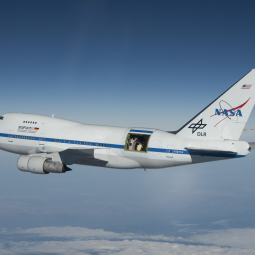The Stratospheric Observatory for Infrared Astronomy, or SOFIA, began its fourth annual cycle of science flights on February 3, 2016.
SOFIA is a heavily modified Boeing 74SP jetliner that carries a 100-inch (2.5-meter) telescope to altitudes between 39,000 to 45,000 feet (12 to 14 km), above more than 99 percent of Earth's atmospheric water vapor, giving astronomers the ability to study celestial objects at infrared wavelengths that cannot be seen from ground-based observatories.
Erick Young, SOFIA’s Science Mission Operations Director, said, “During the Feb. 3 flight, the target objects ranged from a young planetary system around the naked-eye star Vega, only 25 light years from us, to a colicky infant star 1,500 light years away in the Orion star forming region, to a supermassive black hole hidden behind dense dust clouds in the center of a galaxy at a distance of 170 million light years.” Scientists from the University of Georgia, University of Arizona, University of Texas at San Antonio, and the Space Telescope Science Institute in Baltimore, plus their collaborators from institutions in the United States and Europe, obtained data using the FORCAST infrared camera and spectrometer mounted on SOFIA’s telescope.
Pamela Marcum, NASA's SOFIA Project Scientist, said, "Plans for Cycle 4 include 106 flights with more than 550 hours of science observations between now and the end of January 2017. Those research projects span the full gamut of astronomical topics including planets, moons, asteroids and comets in our solar system; star and planet formation; extrasolar planets and the evolution of planetary systems; the interstellar medium and interstellar chemistry; the nucleus of the Milky Way galaxy, and nearby normal and active galaxies.” SOFIA’s suite of seven cameras, spectrometers, and high-speed photometers will be joined by the HAWC+ far-infrared camera and polarimeter that will be commissioned in two phases during 2016. A list of the selected SOFIA Cycle 4 programs is available on the results page.
The SOFIA observatory is scheduled to deploy to the Southern Hemisphere for seven weeks in June-July 2016, with 24 science flights planned from a base at Christchurch, New Zealand. There, scientists will have the opportunity to observe areas of interest such as the Galactic Center and other parts of the Milky Way that are not visible or difficult to observe from the Northern Hemisphere.
SOFIA is a joint project of NASA and the German Aerospace Center (DLR). The aircraft is based at NASA Armstrong Flight Research Center's facility in Palmdale, California. NASA's Ames Research Center in Moffett Field, California, manages the SOFIA science and mission operations in cooperation with the Universities Space Research Association (USRA) headquartered in Columbia, Maryland, and the German SOFIA Institute (DSI) at the University of Stuttgart.
Points of Contact
Nicholas A. Veronico, SOFIA News Officer
SOFIA Science Center, NASA Ames Research Center, Moffett Field, Calif.
650-224-8726
nicholas.a.veronico@nasa.gov
/
nveronico@sofia.usra.edu
Dana Backman, SOFIA Outreach Director
SOFIA Science Center, NASA Ames Research Center, Moffett Field, Calif.
650-604-2128
dbackman@sofia.usra.edu
/
dbackman@seti.org
